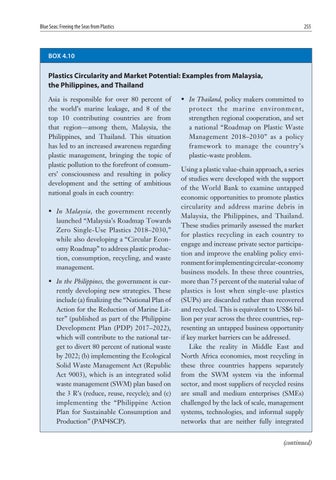Blue Seas: Freeing the Seas from Plastics
255
BOX 4.10
Plastics Circularity and Market Potential: Examples from Malaysia, the Philippines, and Thailand Asia is responsible for over 80 percent of the world’s marine leakage, and 8 of the top 10 contributing countries are from that region—among them, Malaysia, the Philippines, and Thailand. This situation has led to an increased awareness regarding plastic management, bringing the topic of plastic pollution to the forefront of consumers’ consciousness and resulting in policy development and the setting of ambitious national goals in each country: • In Malaysia, the government recently launched “Malaysia’s Roadmap Towards Zero Single-Use Plastics 2018–2030,” while also developing a “Circular Economy Roadmap” to address plastic production, consumption, recycling, and waste management. • In the Philippines, the government is currently developing new strategies. These include (a) finalizing the “National Plan of Action for the Reduction of Marine Litter” (published as part of the Philippine Development Plan (PDP) 2017–2022), which will contribute to the national target to divert 80 percent of national waste by 2022; (b) implementing the Ecological Solid Waste Management Act (Republic Act 9003), which is an integrated solid waste management (SWM) plan based on the 3 R’s (reduce, reuse, recycle); and (c) implementing the “Philippine Action Plan for Sustainable Consumption and Production” (PAP4SCP).
• In Thailand, policy makers committed to protect the marine environment, strengthen regional cooperation, and set a national “Roadmap on Plastic Waste Management 2018–2030” as a policy framework to manage the country’s plastic-waste problem. Using a plastic value-chain approach, a series of studies were developed with the support of the World Bank to examine untapped economic opportunities to promote plastics circularity and address marine debris in Malaysia, the Philippines, and Thailand. These studies primarily assessed the market for plastics recycling in each country to engage and increase private sector participation and improve the enabling policy environment for implementing circular-economy business models. In these three countries, more than 75 percent of the material value of plastics is lost when single-use plastics (SUPs) are discarded rather than recovered and recycled. This is equivalent to US$6 billion per year across the three countries, representing an untapped business opportunity if key market barriers can be addressed. Like the reality in Middle East and North Africa economies, most recycling in these three countries happens separately from the SWM system via the informal sector, and most suppliers of recycled resins are small and medium enterprises (SMEs) challenged by the lack of scale, management systems, technologies, and informal supply networks that are neither fully integrated (continued)






